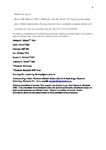Explaining unexplained pain to fibromyalgia patients: finding a narrative that is acceptable to patients and provides a rationale for evidence based interventions
| dc.contributor.author | Hyland, ME | |
| dc.contributor.author | Hinton, C | |
| dc.contributor.author | Hill, C | |
| dc.contributor.author | Whalley, Ben | |
| dc.contributor.author | Jones, Rupert | |
| dc.contributor.author | Davies, AF | |
| dc.date.accessioned | 2016-10-24T14:35:18Z | |
| dc.date.available | 2016-10-24T14:35:18Z | |
| dc.date.issued | 2016-08-01 | |
| dc.identifier.issn | 2049-4637 | |
| dc.identifier.issn | 2049-4645 | |
| dc.identifier.uri | http://hdl.handle.net/10026.1/6610 | |
| dc.description.abstract |
<jats:p> As the cause of fibromyalgia is controversial, communicating with patients can be challenging, particularly if the patient adopts the narrative ‘I am damaged and so I need a more powerful pain killer’. Research shows that providing patients with alternative narratives can be helpful, but it remains unclear what particular narratives are most acceptable to patients and at the same time provide a rationale for evidence based psychological and exercise interventions. This article described the development of a new narrative and the written comments made about the narrative by fibromyalgia patients. The narrative derives from a complexity theory model and provides an alternative to biogenic and psychogenic models. The model was presented to 15 patients whose comments about comprehensibility led to the final format of the narrative. In the final form, the body is presented as ‘a very, very clever computer’ where fibromyalgia is caused by a software rather than a hardware problem. The software problem is caused by the body adapting when people have to ‘keep going’ despite ‘stop signals’, such as pain and fatigue. The narrative provides a rationale for engaging in psychological and exercise interventions as a way of correcting the body’s software. This way of explaining fibromyalgia was evaluated by a further 25 patients attending a 7-week ‘body reprogramming’ intervention, where the therapy was presented as correcting the body’s software, and included both exercise and psychological components. Attendance at the course was 85%. Thematic analysis of written patient feedback collected after each session showed that patients found the model believable and informative, it provided hope and was empowering. Patients also indicated that they had started to implement lifestyle change with perceived benefit. Fibromyalgia patients appear to respond positively to a technology-derived narrative based on the analogy of the body as a computer. </jats:p> | |
| dc.format.extent | 156-161 | |
| dc.format.medium | Print-Electronic | |
| dc.language | en | |
| dc.language.iso | en | |
| dc.publisher | SAGE Publications | |
| dc.subject | Fibromyalgia | |
| dc.subject | adherence | |
| dc.subject | communication | |
| dc.subject | empowerment | |
| dc.subject | illness model | |
| dc.subject | medically unexplained symptoms | |
| dc.subject | pain | |
| dc.subject | qualitative | |
| dc.title | Explaining unexplained pain to fibromyalgia patients: finding a narrative that is acceptable to patients and provides a rationale for evidence based interventions | |
| dc.type | journal-article | |
| dc.type | Journal Article | |
| plymouth.author-url | https://www.ncbi.nlm.nih.gov/pubmed/27583142 | |
| plymouth.issue | 3 | |
| plymouth.volume | 10 | |
| plymouth.publication-status | Accepted | |
| plymouth.journal | British Journal of Pain | |
| dc.identifier.doi | 10.1177/2049463716642601 | |
| plymouth.organisational-group | /Plymouth | |
| plymouth.organisational-group | /Plymouth/Faculty of Health | |
| plymouth.organisational-group | /Plymouth/Faculty of Health/School of Psychology | |
| plymouth.organisational-group | /Plymouth/REF 2021 Researchers by UoA | |
| plymouth.organisational-group | /Plymouth/REF 2021 Researchers by UoA/UoA03 Allied Health Professions, Dentistry, Nursing and Pharmacy | |
| plymouth.organisational-group | /Plymouth/REF 2021 Researchers by UoA/UoA03 Allied Health Professions, Dentistry, Nursing and Pharmacy/UoA03 Allied Health Professions, Dentistry, Nursing and Pharmacy MANUAL | |
| plymouth.organisational-group | /Plymouth/REF 2021 Researchers by UoA/UoA04 Psychology, Psychiatry and Neuroscience | |
| plymouth.organisational-group | /Plymouth/Research Groups | |
| plymouth.organisational-group | /Plymouth/Research Groups/Centre for Brain, Cognition and Behaviour (CBCB) | |
| plymouth.organisational-group | /Plymouth/Research Groups/Centre for Brain, Cognition and Behaviour (CBCB)/Behaviour | |
| plymouth.organisational-group | /Plymouth/Research Groups/FoH - Community and Primary Care | |
| plymouth.organisational-group | /Plymouth/Research Groups/Institute of Health and Community | |
| plymouth.organisational-group | /Plymouth/Research Groups/Institute of Translational and Stratified Medicine (ITSMED) | |
| plymouth.organisational-group | /Plymouth/Research Groups/Institute of Translational and Stratified Medicine (ITSMED)/CCT&PS | |
| plymouth.organisational-group | /Plymouth/Research Groups/Plymouth Institute of Health and Care Research (PIHR) | |
| plymouth.organisational-group | /Plymouth/Users by role | |
| plymouth.organisational-group | /Plymouth/Users by role/Academics | |
| dc.publisher.place | England | |
| dcterms.dateAccepted | 2016-02-26 | |
| dc.identifier.eissn | 2049-4645 | |
| dc.rights.embargoperiod | No embargo | |
| rioxxterms.versionofrecord | 10.1177/2049463716642601 | |
| rioxxterms.licenseref.uri | http://www.rioxx.net/licenses/all-rights-reserved | |
| rioxxterms.licenseref.startdate | 2016-08-01 | |
| rioxxterms.type | Journal Article/Review |


